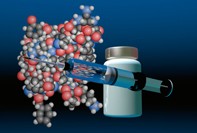Peer Reviewed
Diabetes clinic
Game changers in type 2 diabetes: adding insulin to hypoglycaemics
Abstract
The first three medication steps in long-term glycaemic control for people with type 2 diabetes are relatively easy – the use of one, then two and then three hypoglycaemic agents – but doctors and patients are often reluctant to take the next step and may unnecessarily delay starting insulin therapy.
Key Points
The Diabetes Australia guidelines for the first line primary care of adults with type 2 diabetes, Diabetes Management in General Practice, suggest an evidence-based hierarchy for the use of hypoglycaemic agents, as shown in Figure 1. Most GPs start with metformin, add a sulfonylurea and then consider adding a glitazone or one of the newer glucagon-like peptide-1 (GLP-1) therapies (exenatide and the dipeptidyl peptidase-4 [DPP-4] inhibitors, or gliptins). However, despite taking maximal doses of several hypoglycaemic agents, most patients with type 2 diabetes will need insulin therapy some five to 10 years after diagnosis to achieve good glycaemic control.
Purchase the PDF version of this article
Already a subscriber? Login here.

